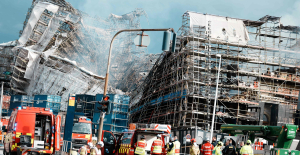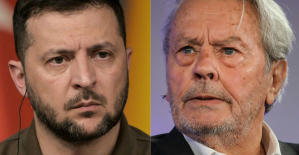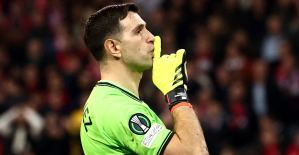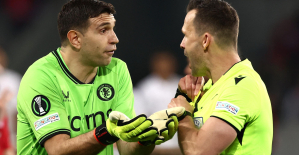Violence in Iran is increasing. Videos show burning barricades in the middle of the capital, Tehran. Demonstrators chanting "Death to the dictator!" (referring to supreme religious leader Ali Khamenei) and "Woman, life, freedom!", the rallying cries of nearly a month's anti-Islamic Republic protests.
Apparently, the demonstrators are increasingly defending themselves against the regime's henchmen, who brutally attack and abduct them, sometimes beat them to death and shoot them. State media speak of 20 dead police officers. According to human rights organizations, more than 200 demonstrators have been killed, including children.
News from Iran is difficult to verify. The regime is currently not allowing foreign journalists to enter the country. At the same time, it arrested scores of local reporters who dared to cover the demonstrations. There is no free press in Iran. The media around the world are dependent on videos, photos and eyewitness reports from local people, who put themselves in massive personal danger because the regime is trying to suppress any news abroad.
Intelligence services are blocked, the Internet is massively throttled. An eyewitness to the protests in the province of Kurdistan, for example, writes WELT that communicating with the outside world is a high risk: "One of my relatives is in police custody only because of a random check on her cell phone. They control everything, even the log files on the phone.”
It is therefore impossible to precisely define the extent of the protests. But this much is clear: The rallies, which began with the death of Mahsa Jina Amini, a 22-year-old woman who was arrested and beaten by vice squads for wearing the mandatory headscarf "too carelessly", have had a major impact country expanded. Protests are reported from all 31 provinces. The fighting in the province of Kurdistan, where Amini comes from, is particularly fierce.
Apparently the regime is trying to make the Kurds a scapegoat and make an example of them. The Iranian human rights organization Hengaw, registered in Norway, said that the Kurdish areas were under a "full-scale military attack".
At least 32 people have been killed there since the protests began. Videos allegedly from Sanandaj show military convoys driving through the provincial capital. According to one demonstrator, shots were also fired there. “Several demonstrators were injured. Riot police are everywhere," he told Reuters.
The inhabitants had apparently managed to gain control over large parts of the city. State buildings were set on fire. In the meantime, the regime has sealed off and besieged Sanandaj from the outside world. It is difficult for individual reports to get out that speak of massive violence against the residents. Videos show people being hit by gunfire.
Yahya Rahimi, a young man who honked his horn as he drove past a demonstration to show his solidarity, was reportedly shot in the head. Ismail Dezwar, a Kurd demonstrating in Saqqez, was reportedly arrested and tortured to death by Islamic Revolutionary Guards Corps (IRGC) members, reports Iran Human Rights Monitor. These are just two examples.
In addition, the regime repeatedly attacks Iranian-Kurdish rebel camps in neighboring Iraq with rockets and artillery. However, the Iranian government's framing that "foreign forces" such as the United States, Israel and Kurdish separatists are behind the protests is unlikely to catch on. In the meantime, they have captured too large a part of the population for that. Female students led the protests. However, various ethnic minorities and members of the lower and middle classes are now also taking part.
The traders in the Grand Bazaar in Tehran, who have traditionally been close to the clergy, have been hit hard by the ongoing economic crisis in Iran. The bar association and the teachers' union have called for strikes. And: workers in the oil, petrochemical and gas industries. This is a significant expansion as the oil and gas sector is the mainstay of Iran's economy.
The strikes come at the worst possible time for the regime. Iran hopes to capitalize on sanctions against Russian oil sales. Tehran would have to succeed in convincing the West to relax sanctions against Iran. At the moment, however, the opposite is the case: The USA, the EU, Great Britain and Canada have decided on new sanctions against the Islamic regime because of the brutal crackdown on the demonstrators.
"This is the most significant wave of protests since the Islamic revolution," says Israeli Iran expert Raz Zimmt, author of the recently published book Inside Iran. State and Society in the Islamic Republic”. Still, two important factors are missing for a revolution that could overthrow the regime. First: A coup by forces loyal to the regime who join the uprising.
Isolated videos show how alleged members of the police and paramilitary forces join the demonstrators. But no one can stand up to the heavily armed Revolutionary Guards, who are strongly networked both socially and economically. And second: An oppositional force that opponents of the regime can agree on. So far, there is no such thing in sight either at home or abroad.

 Sydney: Assyrian bishop stabbed, conservative TikToker outspoken on Islam
Sydney: Assyrian bishop stabbed, conservative TikToker outspoken on Islam Torrential rains in Dubai: “The event is so intense that we cannot find analogues in our databases”
Torrential rains in Dubai: “The event is so intense that we cannot find analogues in our databases” Rishi Sunak wants a tobacco-free UK
Rishi Sunak wants a tobacco-free UK In Africa, the number of millionaires will boom over the next ten years
In Africa, the number of millionaires will boom over the next ten years WHO concerned about spread of H5N1 avian flu to new species, including humans
WHO concerned about spread of H5N1 avian flu to new species, including humans New generation mosquito nets prove much more effective against malaria
New generation mosquito nets prove much more effective against malaria Covid-19: everything you need to know about the new vaccination campaign which is starting
Covid-19: everything you need to know about the new vaccination campaign which is starting The best laptops of the moment boast artificial intelligence
The best laptops of the moment boast artificial intelligence Bitcoin halving: what will the planned reduction in emissions from the queen of cryptos change?
Bitcoin halving: what will the planned reduction in emissions from the queen of cryptos change? The Flink home shopping delivery platform will be liquidated in France
The Flink home shopping delivery platform will be liquidated in France Bercy threatens to veto the sale of Biogaran (Servier) to an Indian industrialist
Bercy threatens to veto the sale of Biogaran (Servier) to an Indian industrialist Switch or signaling breakdown, operating incident or catenaries... Do you speak the language of RATP and SNCF?
Switch or signaling breakdown, operating incident or catenaries... Do you speak the language of RATP and SNCF? The main facade of the old Copenhagen Stock Exchange collapsed, two days after the fire started
The main facade of the old Copenhagen Stock Exchange collapsed, two days after the fire started Alain Delon decorated by Ukraine for his support in the conflict against Russia
Alain Delon decorated by Ukraine for his support in the conflict against Russia Who’s Who launches the first edition of its literary prize
Who’s Who launches the first edition of its literary prize Sylvain Amic appointed to the Musée d’Orsay to replace Christophe Leribault
Sylvain Amic appointed to the Musée d’Orsay to replace Christophe Leribault Skoda Kodiaq 2024: a 'beast' plug-in hybrid SUV
Skoda Kodiaq 2024: a 'beast' plug-in hybrid SUV Tesla launches a new Model Y with 600 km of autonomy at a "more accessible price"
Tesla launches a new Model Y with 600 km of autonomy at a "more accessible price" The 10 best-selling cars in March 2024 in Spain: sales fall due to Easter
The 10 best-selling cars in March 2024 in Spain: sales fall due to Easter A private jet company buys more than 100 flying cars
A private jet company buys more than 100 flying cars This is how housing prices have changed in Spain in the last decade
This is how housing prices have changed in Spain in the last decade The home mortgage firm drops 10% in January and interest soars to 3.46%
The home mortgage firm drops 10% in January and interest soars to 3.46% The jewel of the Rocío de Nagüeles urbanization: a dream villa in Marbella
The jewel of the Rocío de Nagüeles urbanization: a dream villa in Marbella Rental prices grow by 7.3% in February: where does it go up and where does it go down?
Rental prices grow by 7.3% in February: where does it go up and where does it go down? With the promise of a “real burst of authority”, Gabriel Attal provokes the ire of the opposition
With the promise of a “real burst of authority”, Gabriel Attal provokes the ire of the opposition Europeans: the schedule of debates to follow between now and June 9
Europeans: the schedule of debates to follow between now and June 9 Europeans: “In France, there is a left and there is a right,” assures Bellamy
Europeans: “In France, there is a left and there is a right,” assures Bellamy During the night of the economy, the right points out the budgetary flaws of the macronie
During the night of the economy, the right points out the budgetary flaws of the macronie These French cities that will boycott the World Cup in Qatar
These French cities that will boycott the World Cup in Qatar Europa Conference League: the semi-final flies to Lille, which loses to the wire against Aston Villa
Europa Conference League: the semi-final flies to Lille, which loses to the wire against Aston Villa Lille-Aston Villa: Cash disgusts Lille, the arbitration too... The tops and the flops
Lille-Aston Villa: Cash disgusts Lille, the arbitration too... The tops and the flops Handball: Les Bleues in the same group as Spain at Euro 2024
Handball: Les Bleues in the same group as Spain at Euro 2024 Europa Conference League: for Létang, Martinez “does not have the attitude of a high-level athlete”
Europa Conference League: for Létang, Martinez “does not have the attitude of a high-level athlete”


















